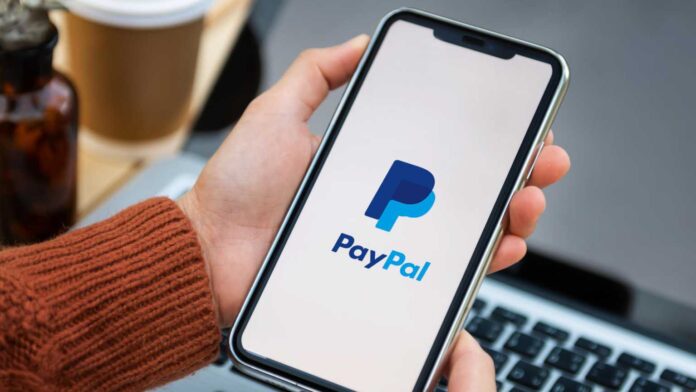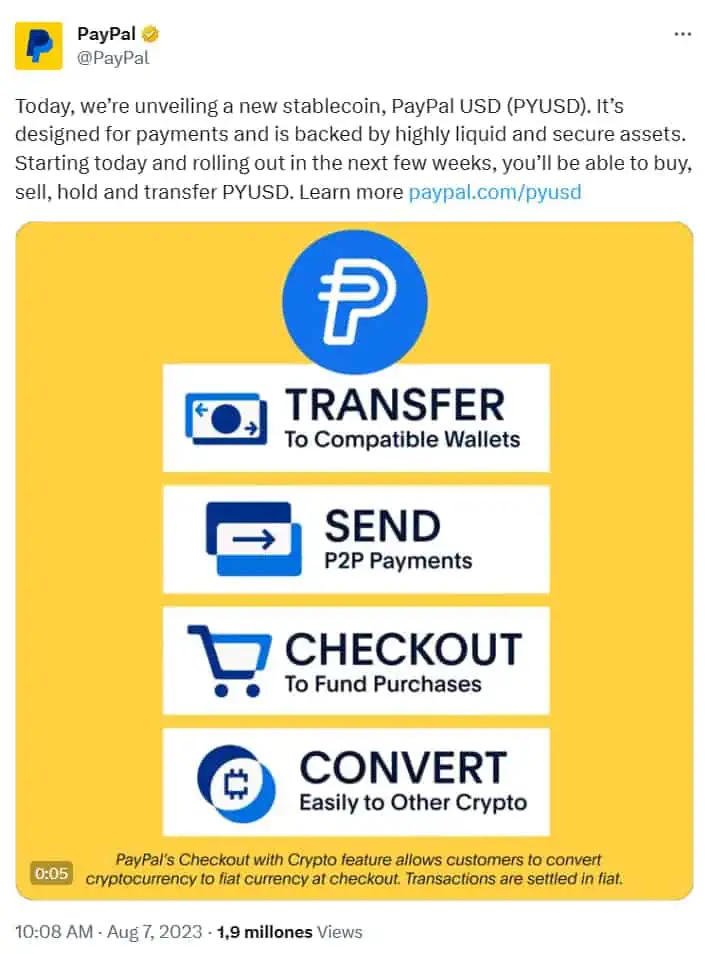
Paypal USD (PYUSD) is a US dollar-denominated stablecoin that is based on the Ethereum blockchain.
Internet payment services company Paypal has launched its own stablecoin, called Paypal USD (PYUSD). In a Press release, the company explained that PYUSD is a stablecoin pegged to the value of the US dollar in 1:1 ratio.
This stablecoin was developed as an ERC-20 token on the Ethereum blockchain, which currently uses the Proof of Stake (PoS) consensus mechanism and is one of the largest Web3 ecosystems.
Through this stablecoin, Paypal wants to facilitate the transfer of value, allowing users the ability to send money from person to person through PYUSD. Through the stablecoin, the company also seeks reduce payment friction in new digital environments, strengthen its presence in the blockchain ecosystem and connect its millions of users to the decentralized web.
PYUSD, a dollar-backed stablecoin
According to Paypal, its PYUSD stablecoin is redeemable at any time for US dollars.
The company emphasized that PYUSD is backed by “US dollar deposits, short-term US Treasuries and similar cash equivalents”, ensuring that 1 PYUSD is equal to $1 dollar.

The first reports on the status of PYUSD reserves will be published in December of this year and will be provided by Paxos Trust Company, according to Paypal.
A bridge between fiat money and the Web3
On the other hand, Dan Schulman, president and CEO of Paypal, stated that PYUSD plays an important role in the company's commitment to bring your users and clients closer to the Web3.
According to Schulman, the new stablecoin anchored to the dollar will serve as a bridge to connect fiat money with digital payments of Web3, in order to offer new experiences to all its clients and provide the necessary foundation to contribute to the growth of the virtual environment.
Users of PYUSD, which is developed in conjunction with the company Paxos and which, for now, will only be available to eligible customers in the United States, will be able to make transfers between PayPal wallets and external wallets compatible with the platform, in addition to sending remittances. and peer-to-peer (p2p) payments, finance purchases and exchange PYUSD with any of the cryptocurrencies available on Paypal.
Let us remember that the payment company enabled support for cryptocurrencies such as Bitcoin, Ethereum, among others, in 2020. Later, in 2021, it authorized its users to make payments with crypto assets through its platform and, in 2022, enabled cryptocurrency transactions and withdrawals to external exchanges. All of this has been part of the strategy the company has adopted to stay at the forefront of the next generation of digital payments.
Harnessing the potential of Ethereum
PYUSD will combine Paypal's expertise in payments on a global scale with the speed, cost and programmability of blockchain protocols.
Being based on the Ethereum blockchain, the new stablecoin will be “available to an already large and growing community of third-party developers, wallets and web applications3, can be easily adopted by exchanges and will be implemented to power experiences within the PayPal ecosystem ”, stated the company.
Stablecoins are a form of money, according to the FED
The launch of the PYUSD stablecoin, from Paypal, comes a few weeks after the president of the United States Federal Reserve, Jerome Powell, stated that stablecoins that have a fiat backing can be considered as a form of money in the country.
Powell noted that stablecoins can significantly impact the financial system by streamlining payments, making them faster, more efficient and inclusive.
Recently, Representative Patrick McHenry, Chairman of the U.S. House Committee on Financial Services, highlighted the need for the country to create a regulatory framework for cryptocurrencies, especially stablecoins, to ensure the stability of users and the nation's leadership in the face of these innovations.
McHenry said, following Paypal's statement to announce its stablecoin, that clear regulations and strong consumer protections are essential to enable stablecoins reach their full potential.
Continue reading: The Federal Reserve recognizes stablecoins as a form of money



